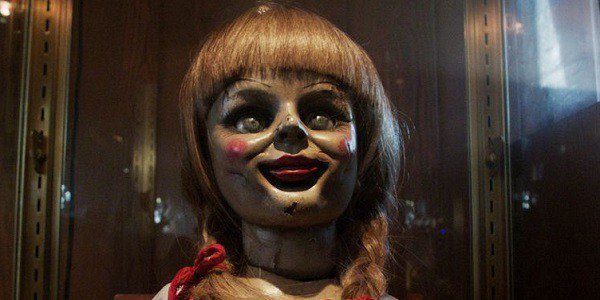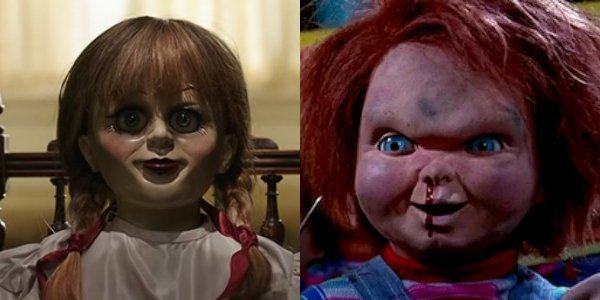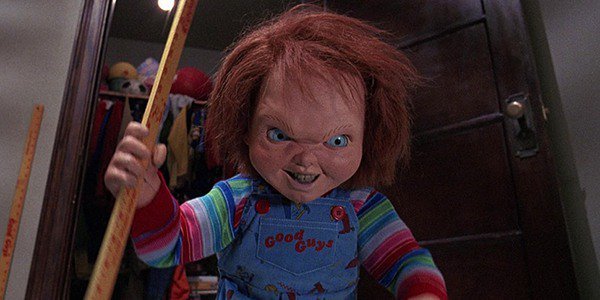Annabelle Vs. Chucky: Who's The Better Killer Doll?


There are Mary Shaw’s dummies in Dead Silence, the creepy puppets from the Puppet Master franchise, that fiendish clown from Poltergeist, and even Gary Busey as The Gingerdead Man. Yet, there are no bloodthirsty inanimate objects quite as iconic as The Conjuring’s Annabelle or the main boogeyman found in Child’s Play, Chucky.
Annabelle and Chucky have been terrorizing unsuspecting innocents for decades, if you count the alleged real-life haunting history that inspired Annabelle, but more on that later. The killer dolls both returned to the big screen this summer in Annabelle Comes Home and a modern reimagining of Child’s Play with a new twist on the character and featuring the voice of Mark Hamill.
While Annabelle Comes Home has made double the killing at the box office over the Child’s Play remake, the real competition lies in the question of which of these dolls is the deadliest. While there is little chance of an Annabelle vs. Chucky crossover movie anytime soon, we can have our own little hypothetical battle right here. Who will win?

Annabelle
Other than Patrick Wilson and Vera Farmiga’s portrayals of real-life demonologists Ed and Lorraine Warren, the most essential connective tissue of The Conjuring Universe is little, creepy-ass doll known as Annabelle. Behind her lingering stare and devilish grin is exactly what you might expect: pure, relentless evil.
Inspired by Ed and Lorraine Warren’s investigation of a haunted Raggedy Ann doll in the 1970s, Annabelle turned out to be a real scene-stealer in James Wan’s 2013 smash hit The Conjuring before starring in her own self-titled spin-off a year later and its sequels: Annabelle: Creation in 2017 and Annabelle Comes Home this year. The character, or “artifact” if you will, has since become, arguably, the most recognizable symbol for evil in The Conjuring Universe.
The thing is, that is all Annabelle really is: a symbol. The doll itself does not walk, talk, or even kill. Other than the occasional slow head turn or suspension of gravity, Annabelle rarely moves because the doll is merely a vessel for which a demon attaches itself to in order to wreak havoc on anyone near.
The demon in question, however, is one mean son of a gun. It manipulates objects and people’s minds’ to nightmarish effect, throws people across rooms like a piece of garbage, has no sympathy for children, and when its appearance is revealed during a pivotal scene of 2014’s Annabelle, it makes the initially unsettling doll appear as friendly as a Barbie.
Your Daily Blend of Entertainment News
Annabelle has the bare minimum of requirements to make you an assured victim of pediophobia (fear of dolls). However, if you already had a fear of dolls prior to the birth The Conjuring Universe, perhaps it was the fault of Annabelle’s opponent in this competition for deadly doll superiority.

Chucky
It may sound like the name that bears purity and innocence, but nowadays, when you hear the name “Chucky,” you cannot help but picture the sociopathic, red-headed, bloodthirsty menace. He is a selfish, uncompromising merchant of death driven by his own inhumanity, most likely because he is barely human himself.
At one time, Chucky was the human Lakeshore Strangler Charles Lee Ray (Brad Dourif) until Detective Mike Norris (Chris Sarandon) shot him in the chest in the climax of an intense chase through a toy store at the beginning of 1988’s Child’s Play. With his fate quickly approaching, Ray finds a solution in a doll part of the popular “Good Guy” toyline, which he transmits his soul into by the use of black magic.
When Karen Barclay (Catherine Hicks) finds a good deal on a “Good Guy” for her son Andy (Alex Vincent) from a street peddler, on the very night she brings it home, strange and tragic things begin to happen. Soon, she discovers that her son’s toy is a new incarnation of a sadistic, foul-mouthed murderer who will stop at nothing to find a new human body to take over.
What sets Chucky apart from other possessed toys of sinister intent is that he has a real “animated” personality that is bigger than his own body, aside from the fact that he is able to walk and talk in his mostly rubber form. He is a criminal of passion, in the sense that he has a real passion for cold-blooded murder and has a snarky quip to follow every kill as an expression of his satisfaction.
While Chucky’s kills are often very gruesome and he obviously loves his knife, he has also been known to take advantage of the supernatural to aid him in his treachery. In the original Child’s Play, when Charles Lee Ray is not strangling innocent people in cold blood, he is practicing voodoo with the help of a man named Dr. Death (Raymond Oliver), whom Chucky, in his doll body, later kills using a voodoo doll.
It is also through the use of voodoo that Chucky transmits the soul of Tiffany Valentine (Jennifer Tilly) into the body of a doll to make her his wife in Bride of Chucky. It also explains how Chucky manages to return for a Child’s Play sequel (which there are six) no matter how many times he is “killed.”
The secret to Chucky’s enduring villainy is not black magic, however, but the love of his fans. Horror hounds come back to see the killer doll in action, even when things got really weird in Seed of Chucky when he and his bride Tiffany have a child, because his dark wit and inventive sadism has made him one of the most beloved slashers in cinematic history.

Annabelle Vs. Chucky
What scares you more: A knife-wielding, trash-talking toy brought to life by the soul of a serial killer or a doll with a grim, unchanging expression with an unwaveringly evil spirit attached to it?
The similarities between Chucky and Annabelle, in essence, begin and end with the juxtaposing appearances of being harmless child’s playthings with more sinister agendas. With that in mind, both have the advantage of being the last suspect any logically-minded person would consider in a murder investigation and could make any deadly occurrence look like an accident.
As for how deadly each doll really is, Annabelle, despite a few fatal encounters, has never been much of a killer. The demon that resides in the doll is less concerned with taking lives and more interested in claiming souls in attempt to possess the living.
Chucky has a similar goal, given that his plastic body was only meant to be temporary at first, but he has no trouble slashing people up until he finds a human host. In fact, as of 2017’s Cult of Chucky, the doll has racked up a body count of 38 since the original Child’s Play, with a new inventive method for each victim and funny quip to match.
Annabelle, even during her films’ most frightening moments, is never the scariest thing about a scene. The doll’s unchanging expression is deeply unsettling, but severely lacks in personality.
What makes Chucky so entertaining and memorable is how animated and menacing he is and his relentlessness to keep anyone out of his way, even after “death,” makes him a force to be reckoned with. Annabelle is not nearly as deadly and will never be as iconic as Chucky.
Annabelle, your grim expression and demonic deeds make you the stuff of nightmares. However, Chucky’s endless tirade of carnage and gigglishly evil and lively persona earns him this win.
This poll is no longer available.

Jason Wiese writes feature stories for CinemaBlend. His occupation results from years dreaming of a filmmaking career, settling on a "professional film fan" career, studying journalism at Lindenwood University in St. Charles, MO (where he served as Culture Editor for its student-run print and online publications), and a brief stint of reviewing movies for fun. He would later continue that side-hustle of film criticism on TikTok (@wiesewisdom), where he posts videos on a semi-weekly basis. Look for his name in almost any article about Batman.
